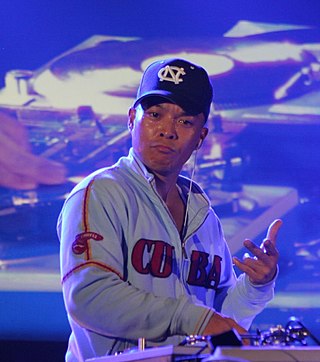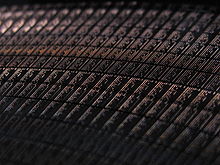Characteristics
Vinyl emulation normally uses special vinyl records which are played on conventional turntables. The vinyl is a recording of analog audio signals often referred to as timecode. The turntables' audio output - the timecode recording - is routed into an analog-to-digital converter, or ADC. This ADC may be a multi-channel soundcard or a dedicated external USB or FireWire audio interface box, DJ controller device or compatible mixer (usually distributed with the software). The ADC sends digital time code information to the software, which then translates the signal into corresponding changes in the playback speed, direction and position of a digital audio file. The audio file will react as if were pressed directly onto the record. The manipulated audio output of the program is then sent back through the DAC or the computer's sound card, and can be routed into an audio mixer where it can be mixed like any other analog audio signal.
The result is digital audio playback that sounds like music manipulated by an analog vinyl recording. However, there is always a short delay between the needle's reading of the time code and the software's playback of the audio. The delay time is treated as a figure of merit for vinyl emulation products. A shorter delay allows the DJ to have better response and control of the music and is usually not noticeable by the user or listener.
In some countries, for example Finland, a digital DJ license is required to legally play copyrighted music publicly with vinyl emulation software.

Beatmatching or pitch cue is a disc jockey technique of pitch shifting or timestretching an upcoming track to match its tempo to that of the currently playing track, and to adjust them such that the beats are synchronized—e.g. the kicks and snares in two house records hit at the same time when both records are played simultaneously. Beatmatching is a component of beatmixing which employs beatmatching combined with equalization, attention to phrasing and track selection in an attempt to make a single mix that flows together and has a good structure.

A disc jockey, more commonly abbreviated as DJ, is a person who plays recorded music for an audience. Types of DJs include radio DJs, club DJs, mobile DJs, and turntablists. Originally, the "disc" in "disc jockey" referred to shellac and later vinyl records, but nowadays DJ is used as an all-encompassing term to also describe persons who mix music from other recording media such as cassettes, CDs or digital audio files on a CDJ, controller, or even a laptop. DJs may adopt the title "DJ" in front of their real names, adopted pseudonyms, or stage names.

A mixing console or mixing desk is an electronic device for mixing audio signals, used in sound recording and reproduction and sound reinforcement systems. Inputs to the console include microphones, signals from electric or electronic instruments, or recorded sounds. Mixers may control analog or digital signals. The modified signals are summed to produce the combined output signals, which can then be broadcast, amplified through a sound reinforcement system or recorded.

Scratching, sometimes referred to as scrubbing, is a DJ and turntablist technique of moving a vinyl record back and forth on a turntable to produce percussive or rhythmic sounds. A crossfader on a DJ mixer may be used to fade between two records simultaneously.

Turntablism is the art of manipulating sounds and creating new music, sound effects, mixes and other creative sounds and beats, typically by using two or more turntables and a cross fader-equipped DJ mixer. The mixer is plugged into a PA system and/or broadcasting equipment so that a wider audience can hear the turntablist's music. Turntablists atypically manipulate records on a turntable by moving the record with their hand to cue the stylus to exact points on a record, and by touching or moving the platter or record to stop, slow down, speed up or, spin the record backwards, or moving the turntable platter back and forth, all while using a DJ mixer's crossfader control and the mixer's gain and equalization controls to adjust the sound and level of each turntable. Turntablists typically use two or more turntables and headphones to cue up desired start points on different records.

Pro Tools is a digital audio workstation (DAW) developed and released by Avid Technology for Microsoft Windows and macOS. It is used for music creation and production, sound for picture and, more generally, sound recording, editing, and mastering processes.

A digital audio workstation (DAW) is an electronic device or application software used for recording, editing and producing audio files. DAWs come in a wide variety of configurations from a single software program on a laptop, to an integrated stand-alone unit, all the way to a highly complex configuration of numerous components controlled by a central computer. Regardless of configuration, modern DAWs have a central interface that allows the user to alter and mix multiple recordings and tracks into a final produced piece.
Traktor is DJ software developed by Native Instruments. It is also used as a sub-brand for Native Instruments' associated DJ hardware products.
Final Scratch is a DJ tool created by the Dutch company N2IT with input from Richie Hawtin and John Acquaviva that allows manipulation and playback of digital audio sources using traditional vinyl and turntables. It seeks to cross the divide between the versatility of digital audio and the tactile control of vinyl turntablism.

A DJ mixer is a type of audio mixing console used by disc jockeys (DJs) to control and manipulate multiple audio signals. Some DJs use the mixer to make seamless transitions from one song to another when they are playing records at a dance club. Hip hop DJs and turntablists use the DJ mixer to play record players like a musical instrument and create new sounds. DJs in the disco, house music, electronic dance music and other dance-oriented genres use the mixer to make smooth transitions between different sound recordings as they are playing. The sources are typically record turntables, compact cassettes, CDJs, or DJ software on a laptop. DJ mixers allow the DJ to use headphones to preview the next song before playing it to the audience. Most low- to mid-priced DJ mixers can only accommodate two turntables or CD players, but some mixers can accommodate up to four turntables or CD players. DJs and turntablists in hip hop music and nu metal use DJ mixers to create beats, loops and so-called scratching sound effects.
Stanton Magnetics, doing business as Stanton, is a business unit of inMusic Brands that designs and markets turntables, cartridges, DJ mixers, DJ media players, and DJ controllers.

A CDJ is a specialized digital music player for DJing. Originally designed to play music from compact discs, many CDJs can play digital music files stored on USB flash drives or SD cards. In typical use, at least two CDJs are plugged into a DJ mixer. CDJs have jog wheels and pitch faders that allow manipulation of the digital music similar to a vinyl record on a DJ turntable. Many have additional features such as loops and beat analysis that are not present on turntables. Additionally, some can function as DJ controllers to control the playback of digital files in DJ software running on a laptop instead of playing the files on the CDJ.

Mixxx is free and open-source software for DJing. It is cross-platform and supports most common music file formats. Mixxx can be controlled with MIDI and HID controllers and timecode vinyl records in addition to computer keyboards and mice.
Record restoration, a particular kind of audio restoration, is the process of converting the analog signal stored on gramophone records into digital audio files that can then be edited with computer software and eventually stored on a hard-drive, recorded to digital tape, or burned to a CD or DVD. The process may be divided into several separate steps performed in the following order:
- Cleaning the record, to prevent unwanted audio artifacts from being introduced in the capture that will necessitate correction in the digital domain, and to prevent unnecessary wear and damage to the stylus used in playback.
- Transcription of the record to another format on another medium ;
- Processing the raw sound file with software in order to remove transient noise resulting from record surface damage ;
- Using software to adjust the volume and equalization;
- Processing the audio with digital and analogue techniques to reduce surface/wideband noise;
- Saving the file in the desired format.

Deckadance is a DJ console and mixing tool developed by Image-Line software and acquired in 2015 by Gibson. Initially released in May 2007, it operates on Windows and Mac OS X, and comes in a House Edition and Club Edition. The latter has support for timecoded vinyl.

Scratch Live is a vinyl emulation software application created by New Zealand based Serato Audio Research, distributed by and licensed exclusively to Rane Corporation. Serato was first known for its Pro Tools plug-in, Pitch N Time, which was sold predominantly to the film industry.

DJ controllers are devices used to help DJs mix music with DJ software using knobs, encoders, jog wheels, faders, backlit buttons, touch strips, and other components.
xwax is an open-source vinyl emulation software. It was initially developed in 2006 as proprietary software. In May 2007 xwax was licensed under the GPL-2.0-only, making it the first open source software of this kind.

Controllerism is the art and practice of using musical software controllers, e.g. MIDI, Open Sound Control (OSC), joystick, etc., to build upon, mix, scratch, remix, effect, modify, or otherwise create music, usually by a Digital DJ or Live PA performer, often called a controllerist. Controllerism is also a nod to traditional musicianship and instrumental-ism paired with modern computer sequencing software such as Ableton Live and Native Instruments Traktor. However a working knowledge of scales and chords is not necessarily required as the performers typically focus their efforts more on sequencing events, software effect and instrument manipulations using buttons, knobs, faders, keys, foot switches and pedals than on instrumental notes played in real time. With recent developments in music technology, particularly in software instruments, a USB MIDI controller enables musicians almost unlimited possibilities to control a wide variety of sound types.

Cross/CrossDJ is a digital vinyl and DJ mixing software developed by the French company Mixvibes. This software provides DJs with a digital platform with which they can mix and perform their music. Since its release in 2008, it has become Mixvibes primary focus.














